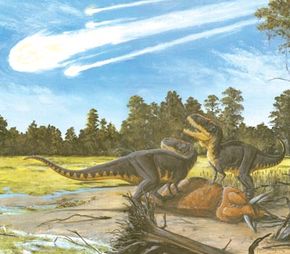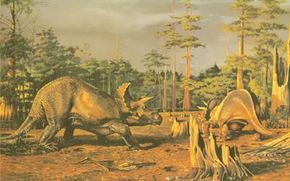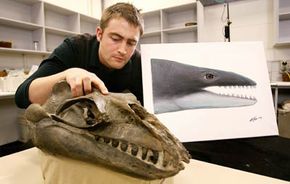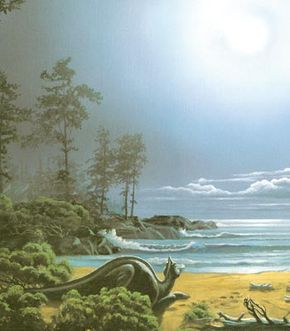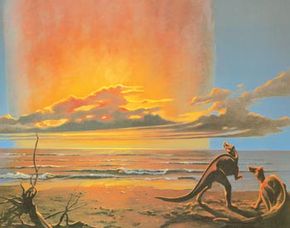The relationship between plants and animals that became extinct at the end of the Cretaceous is important to understanding dinosaur extinction. The reasons for extinction in all these different groups are related. Understanding why another group became extinct may give us clues about dinosaur extinction.
Plants and some animals have a better fossil record than dinosaurs. They also give clues about climate that dinosaur fossils do not. Some marine protozoans (single-celled organisms), called foraminifera, have shells that tell the temperature of the water where the animal lived. By studying the chemical make-up of these tiny fossils, the temperatures of prehistoric seas can be found, and changes in the ocean temperature can be shown. Ocean temperature reflects the climate. This can be used to find out what the climate was like before, during, and after dinosaurs became extinct.
But unlike other scientists, paleontologists cannot go into a laboratory and repeat experiments. They can only untangle history by examining fossils. Unfortunately, there is not enough information and it is often incomplete.
Studying the fossil record can be compared to watching a mystery movie. The paleontologist, though, does not have the whole film. The paleontologist has a film with some parts that are almost complete (every other frame) and others where large chunks (whole reels) are missing. The paleontologist must piece these parts together in order to find out how much of the film is missing.
Paleontologists have come up with a measure of how much of the fossil record is present. The term used is "stratigraphic completeness." Scientists must know how complete the record is in order to find out how long the extinction of dinosaurs took. To use the movie example, it's like trying to find how much time has passed since an event (like a murder) occurred. If all of the frames are present, we know the amount of time. If every other frame is present, we can only say that the event happened within the length of the gap.
Scientists have studied the stratigraphic completeness in the rock formations containing the last dinosaur fossils and in the boundary between the Cretaceous and the Tertiary (the period following the Mesozoic Era). In complete rock units, the best we can say is that dinosaur extinction took less than 100,000 years. In rock units where the sections are less complete, the time frame is longer-even as much as a million years.
In marine rocks (rocks formed in seas or oceans) the record is often more complete. It is here that the earliest and some of the strongest evidence for an extraterrestrial (something from outside the earth's atmosphere) cause for dinosaur extinction has come. Because the record is more complete in marine rocks, the time units studied are much smaller and more accurate. The stratigraphic completeness in rocks deposited in the San Juan Basin (a rock unit in western North America that includes the final phase of dinosaur history) is 100,000 years. In contrast, marine rocks deposited during this same time in Spain allow an interval as short as 10,000 years to be studied. However, these rocks contain no dinosaur fossils.
A second problem with the fossil record is that sometimes fossils can be collected out of place. Recently scientists reported that some dinosaurs may have survived the end of the Cretaceous and lived into the early Tertiary. Workers collected these specimens in rocks above the Cretaceous-Tertiary boundary, with specimens of early Tertiary mammals.
Many paleontologists feel that these specimens were already fossils in the Early Tertiary. They believe that these fossils eroded out of the rocks, and nature reburied them along with the remains of Tertiary mammals. Scientists call this process "reworking" or secondary deposition. It only looks like these animals lived at the same time, even though they lived millions of years apart. Paleontologists must study every specimen carefully.
